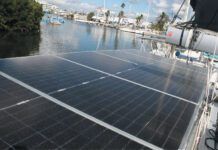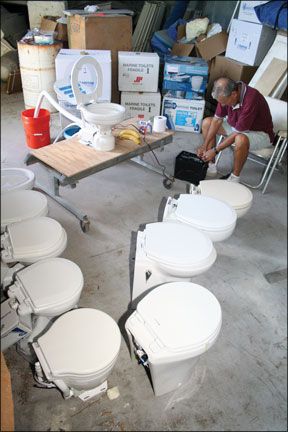
To fully appreciate the seven high-end electric-flush toilets that Practical Sailor recently tested and featured in this article, it helps to understand how they are designed to combat the loathsome clog.
With manual-pump heads, clog resistance usually depends on the discharge pumps ability to pass bulky material-baby wipes, feminine hygiene products, paper towels, and other fibrous paper products-the sort of stuff that shouldnt be in a marine toilet in the first place. Typically, water and material is moved toward the holding tank with a piston pump or diaphragm pump, both of which can push fairly bulky items into the discharge hose.
Backflow from the tank is prevented by check valves, typically a flapper valve, and/or a flexible tricuspid or duck-billed valve that allows water flow in one direction. These, too, can allow some surprisingly large objects to pass into the plumbing system. (See Practical Sailor, September 2000.) In fact, in the days of raw-water intakes and direct overboard discharge, the ability to flush such things as a glove or sock were badges of honor among toilet makers. The old bronze Wilcox-Crittenden Skipper and the Lavac are examples of heads that don’t flinch when you flush a baby-wipe. An ability to flush big stuff is fine, provided you have an endless supply of seawater for flushing and direct overboard discharge.
However, with holding tanks now the norm, anything that makes it past the check valve winds up in a holding tank. In a perfect world, what goes into the tank is easily pumped out, but as anyone who has spent some time at a marine pumpout station can attest-we do not live in a perfect world. To complicate matters, the trend toward freshwater flushing, which reduces odor problems, leaves less water available for flushing. Enter the macerator pump. Like your sinks garbage disposal, macerator pumps chop up material into finer parts, creating an emulsified mixture that can flow freely through the system without building up.
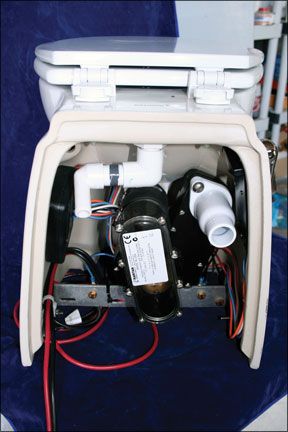
For many years, head macerators had a serious image problem. They were loud and they didnt work. A common design incorporated an impeller to move water and some rotating blades to chop the solids. Typically, both components shared the same motor shaft. Neither was very good at its respective job, especially once a wad of paper wrapped around its blades. Clogs were frequent. Todays macerators are significantly different.
In the mid-1990s, the Italian company Tecma (purchased by Thetford in 2003) changed the perception of macerators with the introduction of a high-speed centrifugal “Vortex” pump, which had a unique convex rotor and a funnel-shaped casing or “volute” that converts kinetic energy into pressure. Other makers soon followed suit with similar designs. Akin to a common bilge pump, the centrifugal pump has a set of curved blades on a rotor. The fast-spinning rotor creates a change in pressure that can quickly push a “slug” of liquid through the system, using very little water and making far less noise than the earlier renditions.
When combined with cutting blades located on the rotor itself or the pump housing, the pump is also very effective at chopping down some surprisingly tough material. Apart from the more obvious differences in sizes, shapes, and buttons for flushingpage, the subtle distinctions in pump design are what set apart the toilets in this months test.
What We Tested
Over the course of two weeks, Practical Sailor testers evaluated 14 toilets from seven manufacturers. The field was divided into two groups, according to toilet size. In last months issue, testers looked at the more compact electric flush toilets that a do-it-yourself boatowner could use to replace a common manual-flush toilet without too much hassle. The toilets in Group I generally had the same footprint as a compact manual flush toilet, and most did not require the addition of a separate water supply pump. Featured Group I manufacturers included Raritan, Jabsco, Johnson, and Groco. Prices ranged from $500 to $1,500.
Best suited for boats over 40 feet, the toilets featured in this article have obvious differences from those in Group I. They are bigger, heavier, more comfortable, more expensive, and are equipped with more sophisticated flushing systems. At around 18 inches tall, they are 4 inches taller than the compact bowls in Group I. The elongated seats and bowls are also bigger.
Manufacturers represented in this round include Dometic, Jabsco, Planus, Raritan, and Tecma. These manufacturers offer a wide range of toilets, allowing boaters to choose colors, sizes, and pump systems that suit their needs. Most of the toilets tested here are offered in a range of sizes, colors, functions, and features. Prices ranged from $700 to $1,500.
Installation details will vary for each toilet and depend on the type of cruising you intend to do. All of the toilets in this test are primarily designed to be flushed with freshwater supplied by an onboard tank via a pressure-regulated pump or a pressurized system. An electronic solenoid valve-often linked to an automatic timing device-controls the water supply.
These toilets can be used with seawater (alone or in addition to the freshwater system) supplied by a separate pump, and some toilets are designed to be simultaneously plumbed to both fresh- and saltwater pumps, allowing the user to select one or the other. However, if you go the saltwater route, keep in mind that good water pressure is essential to proper function. Vented anti-siphon loops on the inlet side will reduce flow and will likely need to be closed during flushing. There are solenoid-controlled vented loops designed for this purpose.
How We Tested
Practical Sailor could not do an onboard, real-life, long-term test and evaluation of so many different toilets, so we conducted a controlled bench test. We compared size, weight, price, style, warranty, features, and functions. We reviewed packing, instructions, documentation, what parts were included, construction and ruggedness of materials, ease of installation, and installation options.
For performance comparison, we hooked up the pumps to a 12-volt battery, installed the proper hoses for water intake and waste discharge, evaluated ease of electrical and plumbing hookup, noted maintenance issues, and compared functions. We tested for amp draw, noise level during flush, and ease of use. We tested the toilets with equal batches of “faux poo,” which consisted of a banana, 4 feet of West Marine single-ply tissue paper, and 1 cup of dyed water. We evaluated the amount, speed, and efficiency of rinse-water input and waste discharge.
Most of these units required pressurized water for filling and rinsing. Many came with a pump on the inlet side to deliver the required pressure, usually around 45 pounds per square inch (psi). To test the units without pumps, we hooked up a standard 3/4-inch garden hose with 48 psi. Theoretically, the toilets that used the garden hose had the advantage of a slightly higher water pressure during fill and rinse cycles, but ultimately, testers did not notice any significant performance advantage in those units that used the garden hose over those that used their own inline inlet pumps.
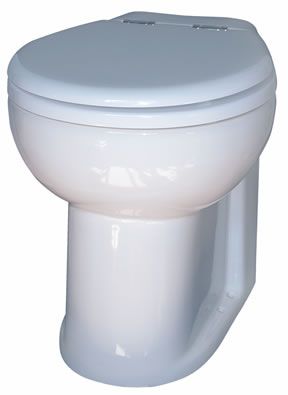
Dometic MasterFlush
As maker of SeaLand marine tanks, hoses, and fittings, Dometic Corp.s responsibility doesn’t end at the flush. If something causes a problem in the holding tank, its Dometics problem, too. As a result, the MasterFlush (8152) is designed as an integral component to the SeaLand sanitation system.
The MasterFlushs water usage was at the higher end of the spectrum among our test toilets, and it has a metal macerator “fan” that finely chops solids. According to the manufacturer, these two features are key to preventing clogs and protecting the system. The company recommends only Sealand toilet paper, but PS testers had no trouble using West Marine TP. (The companys own testing has shown that the macerators able to shred even tampons.) The MasterFlush comes with a remote control unit with three functions: add water to the bowl (activates water valve only), flush (actives water valve and discharge macerator pump), and dry bowl (activates discharge macerator only). Designed for use with pressurized water, this was the tallest and one of the heavier test toilets. Hook up was easy, operation very quiet (second best), the function fast and efficient, and it is relatively inexpensive. Its metal-blade macerator was one of the most effective in dicing a banana.
Bottom line: Quiet, efficient, and cheaper than other products in this group, the MasterFlush is a tie for the Budget Buy.
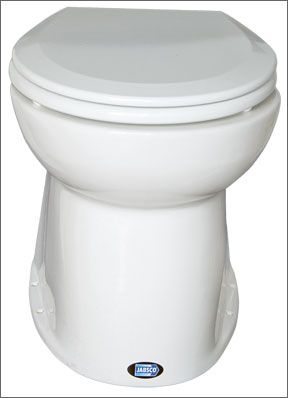
Jabsco Deluxe Flush
Testers noted that this good-looking, one piece, household-size toilet was packed very well. The Deluxe Flush (58040-1012) we tested was designed for pressurized water, and adding an intake pump is an easy option. The 10-page instruction book was one of the better guides in our test. The toilet can be ordered with a straight or slanted back.
The hardware to hold the seat and cover was difficult to figure out. The two nylon nuts and bolts have flat un-slotted heads, making them difficult to tighten. No matter how much testers tightened them, the lid assembly kept slipping. Our test unit had a sealed control panel with pre-set connectors. The four buttons are for pre-programmed, timed fill, quick flush (water saver), flush, and empty (dry bowl). They functioned quite well, although a little slow, and the Deluxe Flush fit the middle price-range of our larger deluxe models.
Bottom line: A good-looking toilet with middle-of-the-pack performance, decent pricing, and an unnerving seat design.
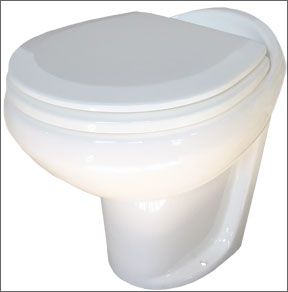
Planus Artic Standard
Planus Marine Toilet Systems are manufactured in Italy and sold through Scandvik Inc. in Vero Beach, Fla. The company president is Marco Giovannini, a marine toilet innovator who founded Tecma. It is no surprise that the Planus toilets have many pump components that are nearly identical to those found on the Tecmas, with some key differences. Among the changes is a stainless-steel valve seat meant to prevent odors from coming back into the toilet. The company offers six very stylish models in 12 color schemes with various available options. High-end models reach all the way up to the Race model, which sells for $9,000. We tested the popular Planus Artic Standard, which came with a remote control box with a switch and a heavy-duty “Electrovalve” solenoid to regulate pressurized water. The heart of the system is its high-speed Vortex discharge pump that Planus claims will push liquid up to 29-feet high.
The Artic is quite heavy, has above-average construction, and came with a pre-wired harness that connected to a sealed electronic box with one pushbutton. It included a heavy-duty bronze inlet pipe with a large solenoid and backflow preventer. Pushing the button starts a timed sequence to add water, quickly flush twice, and then add a little water to leave fresh water in the bowl. A knob on the back of the control box adjusts how much water is left in the bowl after flushing. It is tall and heavy but has a deluxe look; all components are heavy duty; and the operation is very impressive, quiet, and efficient.
Bottom line: Our price-is-no-object Best Choice, the Artic has more oomph than the small-boat owner will likely need (or want to pay for), but this quiet, powerful, clean flusher was the cream of the crop. Only drawback: Planus does not have its own U.S. tech support and parts department, leaving that to the U.S. distributor, Scandvik.
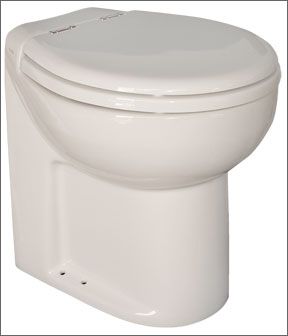
Raritan Marine Elegance
The Raritan 231HS012 is similar to the Marine Elegance unit that was rated the Best Buy in Group I, but with a taller bowl. It also comes with Raritans optional Sea Fresh system, which allows the user to switch between one of two supply sources: a seawater-intake diaphragm pump or pressurized fresh water controlled by solenoid. The switch that controls flushing has four buttons, one for each function: “water only” to manually add water; “empty only” to evacuate bowl as long as button is pushed; “water saver,” which automatically gives two consecutive 1/3-gallon flushes; and “normal flush,” which automatically starts a four-stage cycle of fill, flush, rinse-flush.
This Marine Elegance has a selective rocker switch and hook-up for both seawater and pressurized fresh water, making it an attractive option for extended cruising. All the components and wiring are substantial and well sealed. Despite smaller half-inch inlet and 1-inch diameter outlets, this is a very fast and efficient toilet. Set-up of the dual-water system was understandably more complicated and took a little more time than others in the test.
Bottom line: The versatile big brother to our Best Choice in last months test gets a Recommended rating in this go-round.
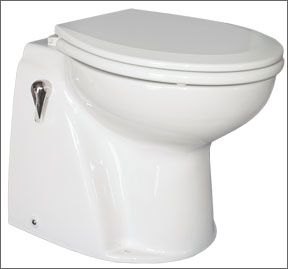
Raritan Atlantes Freedom
This is a heavy, household-style, one-piece porcelain unit with a molded wood seat and cover. The Raritan Atlantes Freedom (A8R12) was the only test product with a chrome manual flush lever on the side. It comes with an 18-page instruction book that can get a little complicated with all the possible functions and options. In the A7 model, the lever activates separate micro switches for fill and flush motors. The A8 adds an electronic timed function to start the fill pump first and then the flush pump. The A9 model has a remote control panel to activate three modes: fill, dry flush, and fill and flush. The “dry flush” function empties the bowl completely of water, a good thing to have for a hard beat.
Our test toilet came with two motors and two pumps, but a solenoid is available for hooking up pressurized water. All the wiring is heavy #8 AWG, and all the parts were well above average in quality and construction. Our sample was very well made and easy to install, and it functioned exceptionally well. The timed operation starts the intake pump to put water in the bowl, flushes for 10 seconds, and then adds a little water, all very quietly. At the back, the macerator pump housing has a unique viewing window, making it easy to confirm a clog and clean it out, if needed.
Bottom line: Initially developed for the houseboat rental market-renowned for marine toilet neophytes-this is an industrial-strength head. Although it will be a tough squeeze in an average cruising boat, it fits the bill for the boat owner with a steady supply of careless visitors or charter guests.
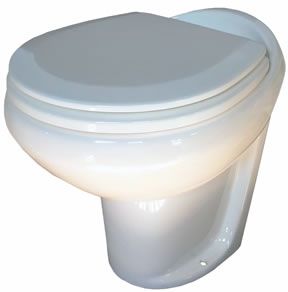
Thetford EasyFit
Thetford offers a wide variety of sanitation, RV, and marine care products. The Tecma EasyFit Eco (38485), made in Michigan, is as tall as other test toilets but has a small footprint and a compact, contemporary, one-piece china bowl. It has an enamel-covered wood seat and a basic, manual, two-position rocker switch.
It can be ordered either with a remote input pump or with a solenoid for pressurized freshwater input. Ours came with the solenoid, a very small 1-inch by 2-inch, two-position activation switch, a pre-wired wiring harness, and an impressive 16-page installation book, which unfortunately did not include an electric wiring diagram. According to Thetford, the wiring diagram is usually included in the same box as the wiring harness. The buttons are not timed: Hold to add water and then hold to flush. Water swirls in the bowl, and the flush is fast and efficient.
Bottom line: Right up there with the Dometic for Budget Buy, this is a no-nonsense electric head, priced right, and compact enough for most cruising sailboats in the 35- to 40-foot range.
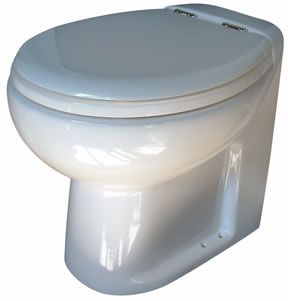
Thetford Silence Plus
A high-end European-style luxury model, the Thetford-Tecma Silence Plus (38660) is assembled in Italy. It is available in three colors and features its powerful turbine macerator pump. The heaviest of the test products, it has a solid porcelain base, epoxy-coated wooden seat and lid, and was one of two 24-volt models tested. It is also available in a 12-volt (30-amp) model. Components are first class. It features an electronic, timed wall switch with two well-marked buttons to “add water” or “flush.” Pushing the “flush” button also adds a little water, then flushes, delays for 5 seconds, and flushes again. It uses a minimum of water, is fast and efficient, and is very quiet except for one little cough at the end of the flush. This was one of the most powerful flushers in the test.
Bottom line: Quiet and efficient, the Tecma Silence Plus, like its distant cousin, the Planus, has some significant pumping power.
Conclusions
Practical Sailors 14 electric marine test toilets ranged from compact utilitarian heads to very stylish-and heavy-thrones. In the compact group reviewed last month, Raritans Marine Elegance was a clear winner, with the Raritan Sea Era and the Jabsco Quiet Flush earning Budget Buy ratings.
In the group of larger models featured this month, the ratings were much closer. Of the three heaviest units, PS testers were most impressed with the Planus Artic Standard, followed closely by the Thetford Silence Plus. Both have smart flush controls, tank-full indicators, and two-year warranties. Both are made in Italy, but the Thetford has much a stronger U.S. presence. For those inclined to stick with domestic brands, the Raritan Atlantes Freedom was right up there in terms of robust construction and solid performance.
In the Budget-Buy category, the Dometic MasterFlush and the Thetford EasyFit Eco were neck-and-neck. Performance and construction details competed closely with more expensive models, and customer service was strong. It had sensible flushing options (including dry bowl), and Dometics new switch, which will have a full-tank indicator, will bring added value.
The Thetford EasyFit stood out with high scores across the board for performance. It is fairly light, installation is straightforward, and performance is fast and quiet. Tech support is reliable, and the two-year warranty is a bonus.
If a switchable, freshwater/raw water model is what you want, then the Raritan Marine Elegance is an obvious choice.
Since many of our readers are long-term cruisers who value simplicity over convenience, we would be remiss not to mention the lingering question underlying both this review and the previous months look at electric flush toilets: Whats wrong with a manual toilet?
True, modern electric-flush marine toilets offer a huge step in convenience over manual models, particularly when you start mixing freshwater flushing and holding tanks. But toilets are mechanical systems whose moving parts have finite lives. Shaft seals on these electric pumps, for example, will eventually start leaking. Key components on these heads are mostly tucked away and difficult to service. Solenoids, motors, sensors, and timers must deal with a corrosive marine environment.
And when we ask a cruiser who is micro-managing amp hours (not to mention fresh water) across the South Pacific for 40 amps (at 24 volts!) every time he wants to flush . . . we can almost feel his nerves flicker with the lights.



































